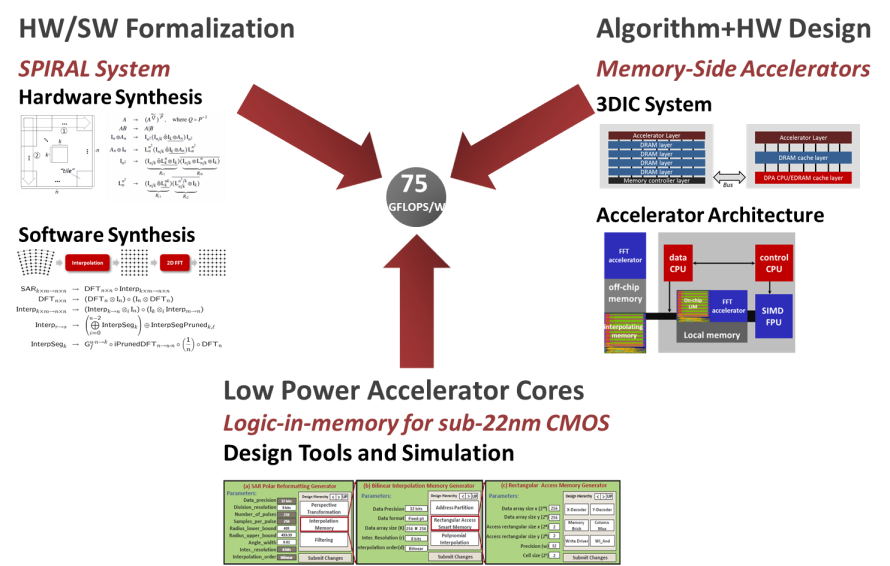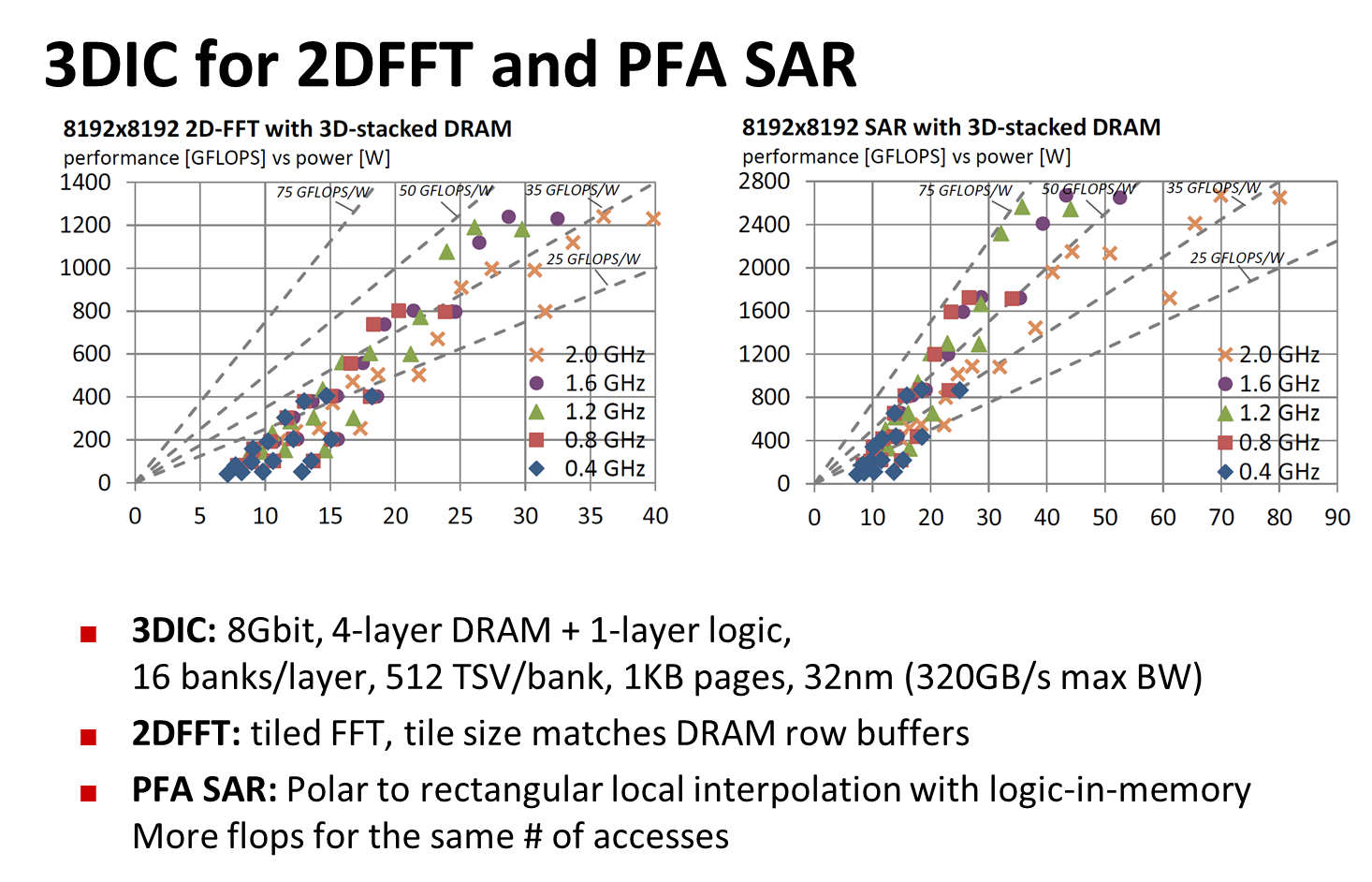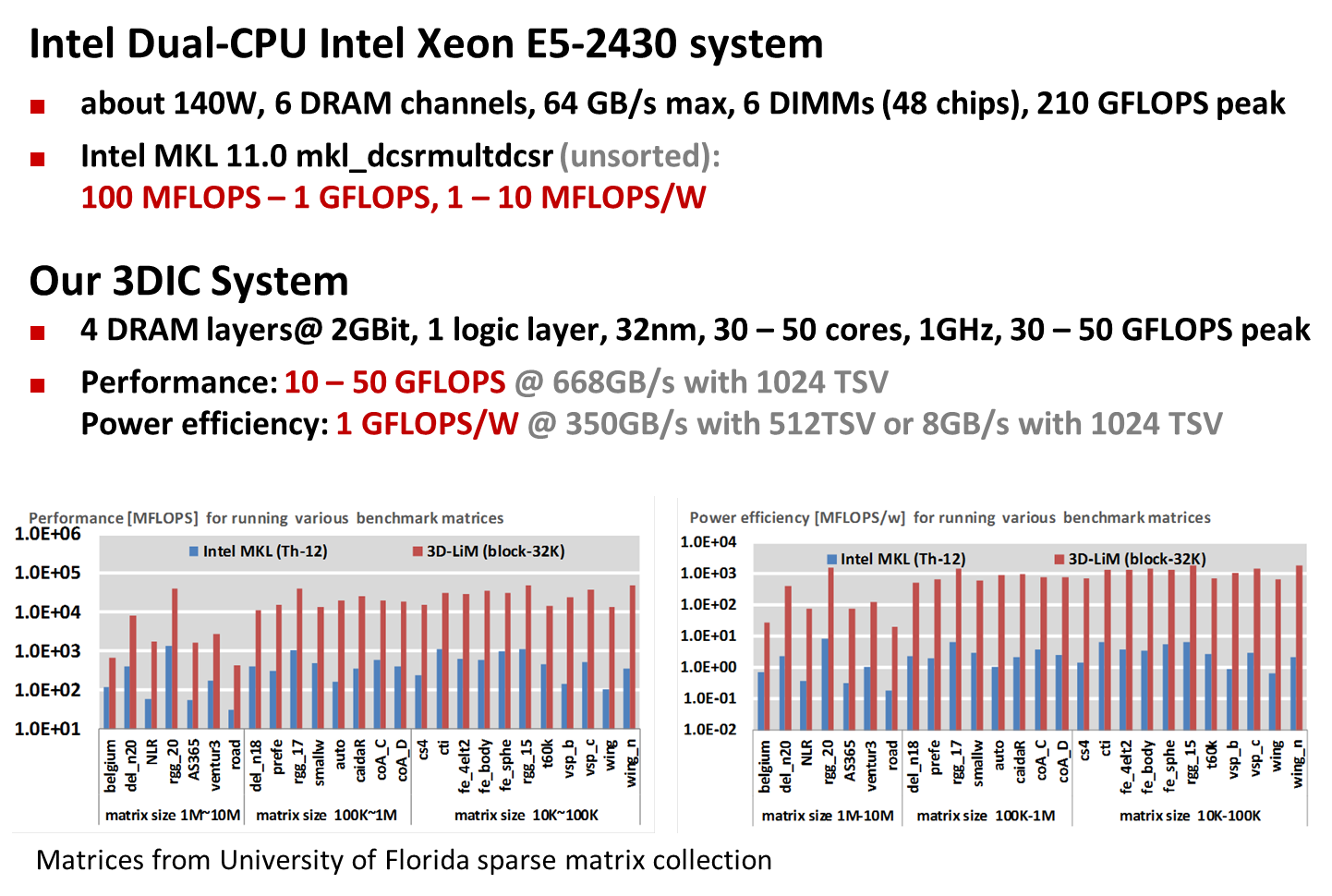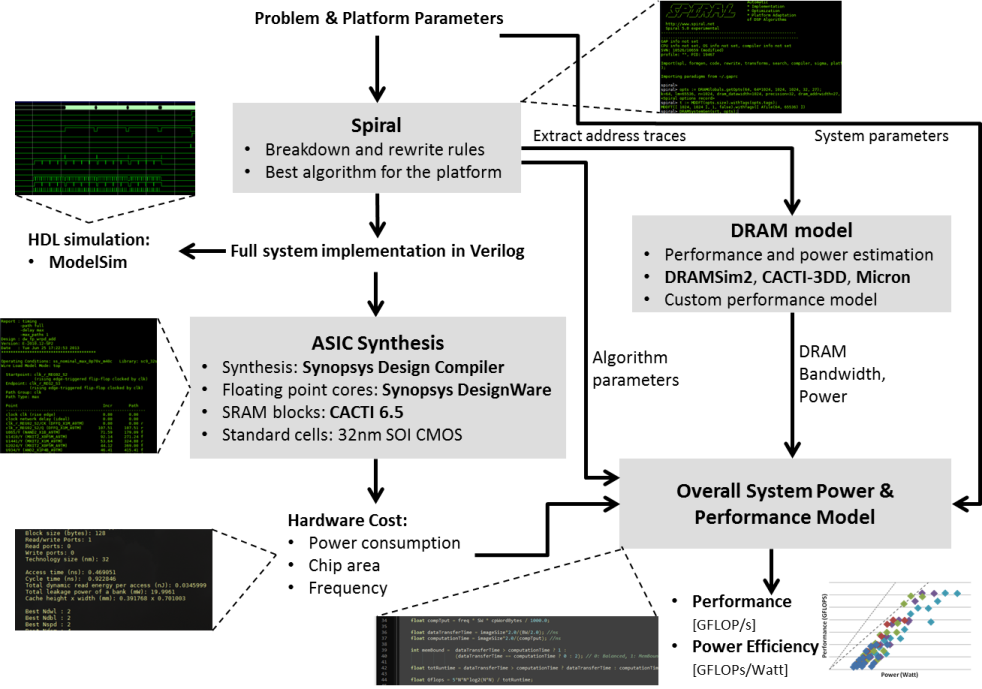Energy Efficient High Performance through Application-Specific Processor/Program Co-Synthesis
(HR00111320007 — DARPA PERFECT)Franz Franchetti (PI), Josť; M. F. Moura (Co-PI), James C. Hoe (Co-PI), Larry Pileggi (Co-PI), Mike Franusich (Co-PI)
Post-Docs: Yusuf Adibelli, Nikos Alachiotis, Qi Guo, Tze Meng Low, Kaushik Vaidyanathan
PhD Students: Thom Popovici, Fazle Sadi, Kuntal Shah, Richard Veras, Guanglin Xu
Engineers: Brian Duff, Jason Larkin
Alumni: Berkin Akin, Aliaksei Sandryhaila, Ekin Sumbul, Qiuling Zhu
Approach
|
The DARPA PERFECT Program develops technology to achieve power efficiency of 75 GFLOPS/W at 7nm for DoD-related applications. Our approach is to deploy algorithm/architecture co-synthesis that leverages 3D chip stacking technology. We are targeting the PERFECT goal of 75 GFLOPS/W from three complementary angles:
|
 |
Results
|
Our major accomplishments in Phase 1 of PERFECT are all demonstrated on a simulated 3DIC system (4 layers of 2Gbit DRAM, 1 layer of logic 32nm technology node, run at 1 GHz - 1.3 GHz). The major tangible accomplishments are three near-DRAM accelerators that have been demonstrated in Phase 1 in detailed full-system (DRAM and logic) simulation:
|
 |
 |
Design and Simulation Tools
Our results were obtained using our tools for design space exploration. We demonstrated for all these kernels the capability to generate and evaluate many design points with various trade-offs to enable users to reach a certain goal for one metric (e.g., at least 1 TFLOPS or no more than 40 Watt) while optimizing the other metric. |
 |
Publications
- B. Akin, F. Franchetti, J. C. Hoe
Data Reorganization in Memory Using 3D-stacked DRAM
42nd International Symposium on Computer Architecture (ISCA), 2015. - H. E. Sumbul, K Vaidyanathan, Q. Zhu, F. Franchetti, L. Pileggi
A Synthesis Methodology for Application-Specific Logic-in-Memory Designs
Proceedings of the 52nd Design Automation Conference (DAC), 2015. - D. A. Popovici, F. Russell, K. Wilkinson, C-K. Skylaris, P. H. J. Kelly, F. Franchetti
Generating Optimized Fourier Interpolation Routines for Density Functional Theory Using SPIRAL
29th International Parallel & Distributed Processing Symposium (IPDPS), 2015. - Q. Guo, N. Alachiotis, B. Akin, F. Sadi, G. Xu, T. M. Low, L. Pileggi, J. Hoe, F. Franchetti
3D-Stacked Memory-Side Acceleration: Accelerator and System Design
wnd Workshop on Near Data Processing (WONDP) in conjunction with the 47th International Symposium on Microarchitectur (MICRO-47), 2014. - B. Akin, F. Franchetti, J. C. Hoe
Understanding the Design Space of DRAM-optimized Hardware FFT Accelerators
Proceedings of the 25th International Conference on Application-Specific Systems, Architectures and Processors (ASAP) 2014, pp. 248-255. - B. Akin, F. Franchetti, J. C. Hoe
HAMLeT: Hardware Accelerated Memory Layout Transform within 3D-stacked DRAM
Proceedings of High Performance Extreme Computing Conference (HPEC) 2014.
Best Paper Award - F. Sadi, B. Akin, D. T. Popovici, J. C. Hoe, L. Pileggi, F. Franchetti
Algorithm/Hardware Co-optimized SAR Image Reconstruction with 3D-stacked Logic in Memory
Proceedings of High Performance Extreme Computing Conference (HPEC) 2014. - Q. Zhu, C. R. Berger, E. L. Turner, L. Pileggi, F. Franchetti
Local Interpolation-based Polar Format SAR: Algorithm, Hardware Implementation and Design Automation
The Journal of Signal Processing Sytems. Springer, 2012. VLSI1782R2. - B. Akin, F. Franchetti, J. C. Hoe
FFTs with Near-Optimal Memory Access Through Block Data Layouts
Proceedings of IEEE International Conference on Acoustics, Speech and Signal Processing (ICASSP), 2014. - Q. Zhu, B. Akin, H. E. Sumbul, F. Sadi, J. Hoe, L. Pileggi, F. Franchetti
A 3D-Stacked Logic-in-Memory Accelerator for Application-Specific Data Intensive Computing
Proceedings of IEEE International 3D Systems Integration Conference (3DIC) 2013, pp. 1-7. - Q. Zhu, H. E. Sumbul, F. Sadi, J. Hoe, L. Pileggi, F. Franchetti
Accelerating Sparse Matrix-Matrix Multiplication with 3D-Stacked Logic-in Memory Hardware
IEEE High Performance Extreme Computing Conference (HPEC), 2013, pp. 1-6.
Best Paper Award
Copyrights to many of the above papers are held by the publishers. The attached PDF files are preprints. It is understood that all persons copying this information will adhere to the terms and constraints invoked by each author's copyright. These works may not be reposted without the explicit permission of the copyright holder. Some links to papers above connect to IEEE Xplore with permission from IEEE, and viewers must follow all of IEEE's copyright policies.
